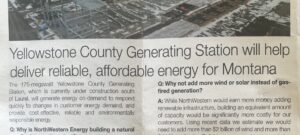By Anne Hedges
 NorthWestern Energy’s recent mailers include misleading responses to reasonable criticism of its plan to double down on fossil fuels.
NorthWestern Energy’s recent mailers include misleading responses to reasonable criticism of its plan to double down on fossil fuels.
After stalling its release last fall, NorthWestern Energy finally released its latest Integrated Resource Plan (IRP) in late April. If the draft plan wasn’t bad enough, the final plan is a difficult-to-decipher but thinly veiled attempt to gouge Montana electricity customers, ignore the climate crisis while pretending to have a meaningful greenhouse gas reduction goal, and make the company’s shareholders rich. NorthWestern’s desire is to become the only utility in the country trying to increase its reliance on expensive and outdated coal technology by acquiring a larger share of the expensive Colstrip plant. Let’s just say, the monopoly utility somehow managed to limbo under our very low expectations.
While NorthWestern clearly tried to hide the ball regarding its intentions for meeting customers’ electricity needs for the next 20 years, a few things are clear: NorthWestern only wants more fossil fuels (both coal and methane gas); it has no intention of reducing carbon emissions for at least a decade; it doesn’t actually want renewable energy; it wants to continue to contemplate whether it should someday engage in energy efficiency and other demand-side management strategies; it continues to misrepresent the state of storage technology; it failed to disclose the serious risks facing the coal industry and the Colstrip plant in particular; and it failed to consider game-changing new federal programs when it comes to the cost of clean energy compared to fossil fuels.
Once again, NorthWestern has refused to consider combining storage with renewable energy, instead considering each separately as if they are unable to complement each other. It didn’t consider the impacts of proposed rules that would require coal to pay its true cost (see article) or how much coal prices will increase when the contract with the mine adjacent to the Colstrip plant needs to be renegotiated at the end of 2025. While NorthWestern acknowledges, finally, that the future of the Colstrip plant is uncertain, it failed to consider how acquiring a bigger share of the plant from Avista would increase the risk to customers from relying even more heavily on the aging plant. It also didn’t mention the increased cost of coal ash maintenance and cleanup from that larger share.
The list goes on. While MEIC and others spend the next couple of months analyzing this IRP, we will keep you informed of what we find. The Montana Public Service Commission (PSC) will accept public comment on the plan in coming months. Watch your email inbox and our website.
During NorthWestern’s previous IRP process, Montanans showed up to the PSC’s public hearings in droves to express their displeasure with NorthWestern’s continued schemes to invest in expensive, polluting fossil fuels – and it had an impact. This round should be no different.
The PSC is required to hold at least two public hearings so you, the public, can weigh in on this incredibly important process. We expect these hearings to be held in the late summer or fall. Contact the PSC to request a hearing in your area: pschelp@mt.gov.
This article was published in the June 2023 issue of Down To Earth.

